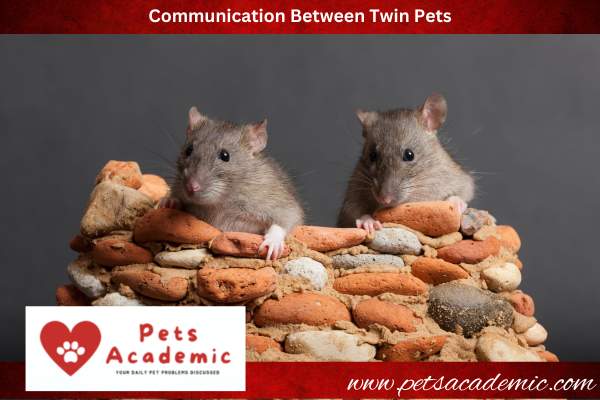Many pet owners have often noticed that their pets seem to have a certain connection with each other and even their owners.
This connection is especially strong in twin pets who share a unique bond that is not often observed in other pets.
This blog post will explore the special connection between twin pets and explain why it is so special.
Twin Pets And Their Special Connection

Twin pets are two pets from the same litter that share a close bond from birth.
This bond is different from that of other pets since they have grown up together and have known each other since birth.
This bond is often described as being telepathic since they can communicate without the use of words.
Twin pets have a remarkable ability to understand each other’s needs and communicate with each other with ease.
This communication is not limited to just verbal communication but extends to non-verbal communication as well.
Twin pets can often understand each other’s body language and movements which make their connection even stronger.
One of the most unique characteristics of twin pets is that they often develop similar personalities and habits which are not observed in other pets.
This may be due to the fact that they have grown up together and have been exposed to the same environment.
It is not uncommon for twin pets to exhibit similar traits such as being active, lazy, or even having the same sleeping patterns.
Twin pets often have a strong sense of loyalty and protection towards their siblings.
This is especially evident when one of the pets is sick or in distress.
Twin pets often try to comfort and protect each other when the other is in trouble.
Bonding Of Twin Pets
Twin pets’ bond is often described as being telepathic since they can communicate without the use of words.
They have a remarkable ability to understand each other’s needs and communicate with each other with ease, including non-verbal communication like body language.
This characteristic makes their bond even stronger.
Twin pets also develop similar personalities and habits, which are rarely observed in other pets.
Growing up together in the same environment contributes to this, and it’s not uncommon for twin pets to exhibit shared traits such as being active, lazy, or having the same sleeping patterns.
In addition to their strong social bond, twin pets also have a sense of loyalty and protection towards each other.
When one pet is sick or in distress, the other pet will often try to comfort and protect their sibling.
The bond shared by twin pets is indeed unique and cherished, making them a special addition to any pet owner’s family.
Communication Between Twin Pets

Twin pets share a unique bond that is not often seen in other pets.
One fascinating aspect of this connection is their remarkable ability to communicate with each other.
Communication between twin pets is a combination of both verbal and non-verbal cues, which strengthens their bond even further.
Non-verbal communication
Non-verbal communication is a significant form of communication between twin pets.
They are capable of understanding each other’s body language, gestures, and facial expressions without the use of words.
This type of communication contributes to their telepathic-like bond with each other.
For instance, when one twin pet is upset, the other pet quickly picks up on these cues and responds accordingly by offering comfort and support.
This non-verbal communication between twin pets is natural to them and often goes unnoticed.
Vocal communication
While non-verbal communication plays an important role in twin pets’ bonding, they also use vocal cues to communicate.
Twin pets have their unique way of vocalizing that only they can understand.
They can convey different levels of information, from playful banter to more serious matters.
Moreover, twin pets’ vocal communication helps them overcome difficult situations.
For instance, when one pet is lost or in a dangerous situation, the other pet will use vocal calls to locate their sibling and help them out of trouble.
In summary, communication between twin pets are unique, personalized, and crucial for their close social bond.
Their ability to communicate without the use of words is a natural instinct that enhances their connection and makes them an exceptional addition to any pet owner’s family.
Benefits Of Having Twin Pets

Twin pets can be a delightful addition to any pet owner’s family.
Not only do they have a unique bond with each other, but having twin pets can also provide several benefits to their owners.
Increased companionship
Twin pets offer an unparalleled level of companionship to their owners.
With their close bond, they often seek comfort and affection not only from each other, but also from their owners.
This means that pet owners with twin pets can expect double the love and attention from their furry friends.
Moreover, having twin pets can also help alleviate loneliness, especially if the owner lives alone.
Reduced separation anxiety
Separation anxiety is a common problem among pets, especially when their owners are away.
However, with twin pets, this can be significantly reduced.
Because twin pets have each other for company, they don’t feel as lonely or anxious when their owner is not around.
This can make leaving them at home for extended periods less stressful for both pets and owners.
Overall, having twin pets can provide increased companionship and reduce separation anxiety for their owners.
Their unique bond with each other also adds a special element to their dynamic, making them a beloved addition to any household.
Challenges of Having Twin Pets

While twin pets can provide numerous benefits, owning them also comes with its own set of challenges.
Pet owners considering getting twin pets should be aware of these challenges beforehand to ensure they are ready to provide the best care for their furry friends.
Littermate syndrome
One of the biggest challenges of having twin pets is the risk of littermate syndrome.
This is a behavioral condition that can develop in twin pets that spend too much time together, resulting in a lack of social skills and reliance on each other instead of their owners.
This can lead to separation anxiety, aggression, and other behavioral issues.
Fortunately, littermate syndrome can be prevented by giving each pet enough individual attention and training.
Pet owners should prioritize bonding with each pet separately and establishing a strong relationship with each of them.
This can help prevent them from becoming too dependent on each other and help them learn important social skills that will benefit them in the long run.
Other challenges of having twin pets may include increased expenses, as twin pets will require twice as much food, healthcare, and other supplies.
Additionally, controlling sibling rivalry can also be a challenge, as twin pets may compete for their owner’s attention and affection.
Despite these challenges, many pet owners find that owning twin pets is a rewarding and fulfilling experience.
As long as pet owners are prepared for the extra work and dedication required to care for twin pets, the benefits of their unique bond can outweigh the challenges they may face.
Training Twin Pets
Training twin pets can be a bit more complicated than training a single pet.
However, with patience and consistency, pet owners can teach their twin pets valuable skills and behaviors.
Establishing individual identities
To start, it’s important for pet owners to establish individual identities for each pet.
This includes giving each pet its own name, feeding them separately, and providing individual playtime and training sessions.
Positive reinforcement
Positive reinforcement is key when training twin pets.
This involves rewarding good behavior with treats, praise, and playtime.
Using this technique consistently can help reinforce good behavior and teach them the desired behavior.
Separate training sessions
It’s also important for pet owners to conduct separate training sessions for each pet.
This allows each pet to receive individual attention and to focus on their own training goals.
It also helps prevent one pet from dominating the session and developing a stronger bond with the owner.
Overall, training twin pets requires extra work and dedication from the owner.
However, with proper training and care, twin pets can be well-behaved, happy, and loving companions.
Caring for Twin Pets

When considering getting twin pets, it is important for pet owners to understand the challenges that come with it.
While twin pets can bring joy and companionship, they also require extra work and dedication on the part of their owner.
One of the biggest challenges of having twin pets is littermate syndrome.
This condition can develop when twin pets spend too much time together and become overly reliant on each other instead of their owners.
It can result in behavioral issues such as separation anxiety, aggression, and other problems.
To prevent littermate syndrome, pet owners should prioritize individual attention and training for each pet.
Bonding with each pet separately and establishing a strong relationship with each one can help prevent them from becoming too dependent on each other and teach them valuable social skills.
Training twin pets may be more complicated than training a single pet, but with patience and consistency, pet owners can teach their twin pets valuable skills and behaviors.
Nutrition considerations for twin pets
Caring for twin pets also involves nutrition considerations.
As they require twice as much food, healthcare, and supplies, increased expenses can be a challenge.
Pet owners must ensure that their pets are receiving adequate nutrition through high-quality pet food.
It is also important to provide individual feeding bowls to prevent food-related aggression and to monitor their dietary intake.
Sibling rivalry can also be an issue as twin pets may compete for their owner’s attention and affection.
Pet owners should establish individual identities for each pet by giving them separate names, providing individual playtime, and training sessions.
Positive reinforcement is key when training twin pets.
Consistently rewarding good behavior with treats, praise, and playtime can help reinforce their good habits and teach them desired behavior.
In conclusion, owning twin pets can require extra work and dedication from the owner.
However, with proper training, care, and separate individual attention and playtime, twin pets can form a unique, fulfilling, and happy bond with each other and their owner.
Conclusion
Having twin pets can be a rewarding and fulfilling experience for both pets and their owners.
While challenges such as littermate syndrome, nutrition, and training may arise, with proper care and dedication, twin pets can develop unique bonds with their owner and each other.
Pet owners must prioritize individual attention and training and ensure each pet receives adequate nutrition and health care for a healthy and happy life together.
More Articles: The fascinating world of animal hierarchies: Who’s really in charge?

